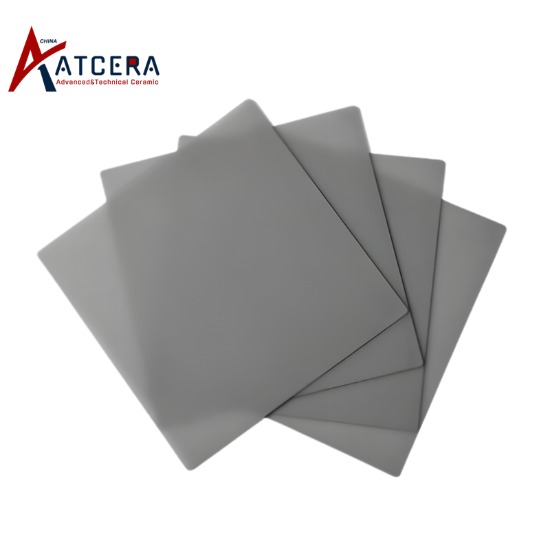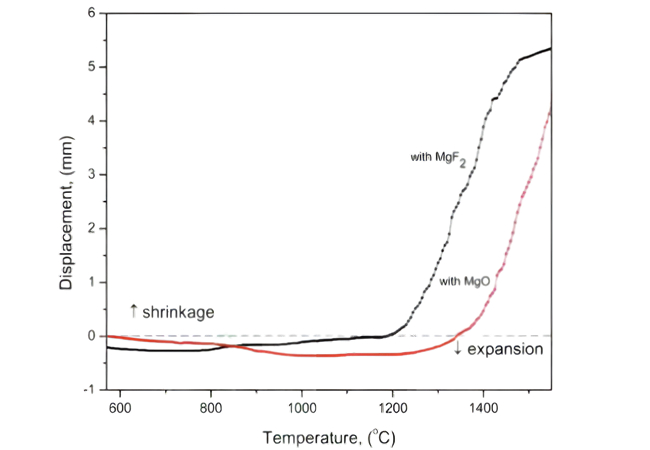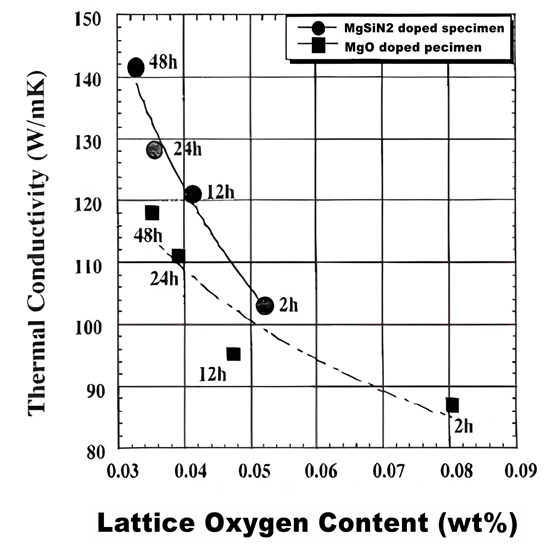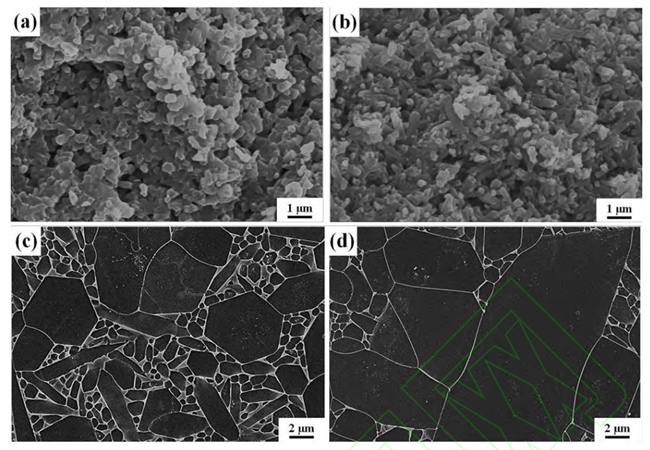À l'heure actuelle, l'avènement de la troisième génération de semi-conducteurs représentés par SiC et GaN a incité le module de puissance à évoluer dans le sens de la miniaturisation, de la haute tension, du courant élevé et de la densité de puissance élevée, ce qui générera une chaleur plus élevée pendant l'utilisation, ce qui met en avant exigences strictes pour le package de dissipation thermique de l'appareil. Dans la nouvelle génération de modules haute puissance, le substrat céramique joue principalement le rôle de support de puce, d'isolation électrique et de canal de conductivité thermique, et la céramique de nitrure de silicium est devenue un matériau de substrat de dissipation thermique avec un grand potentiel d'application en raison de ses avantages de haute résistance thermique. conductivité et propriétés mécaniques élevées.

Comment obtenir un substrat en nitrure de silicium hautes performances présentant à la fois des propriétés mécaniques et une conductivité thermique est aujourd'hui l'un des problèmes les plus préoccupants de l'industrie. En raison du faible coefficient de diffusion des atomes de Si et de N dans le substrat céramique de nitrure de silicium, la transformation de phase, le développement des grains et la densification doivent être obtenus par frittage en phase liquide. Par conséquent, c'est un moyen efficace d'améliorer les propriétés mécaniques et thermiques des céramiques de nitrure de silicium d'ajuster la phase liquide et la micromorphologie dans le processus de frittage avec des additifs de frittage appropriés.
Types d'aides au frittage sans oxyde
Fluorure
Dans une solution de silicate, les atomes de fluor peuvent détruire la structure du réseau de silicate et le faire se décomposer, ce qui réduira la température et la viscosité de la formation de phase liquide et favorisera la densification par frittage. Par exemple, l'utilisation de MgF2 au lieu de MgO comme agent de frittage peut former une phase liquide à une température plus basse, accélérer la densification de la céramique et augmenter la taille des grains avec l'augmentation de l'ajout de MgF2, ce qui peut améliorer efficacement la conductivité thermique de céramiques de nitrure de silicium. De plus, il existe le LiF, le fluorure de terres rares, le fluorure binaire, etc.

La courbe déplacement-température des céramiques Si3N4 a été préparée en utilisant MgF2 et MgO comme additifs de frittage
Les additifs de frittage fluorés évitent l'introduction d'atomes d'oxygène supplémentaires dans le système, réduisent l'activité du SiO2 dans la phase liquide et empêchent la formation d'oxygène dans le réseau pendant le processus de précipitation par dissolution. Dans le même temps, l'énergie atomique du fluor réduit la viscosité de la phase liquide, aide à former la phase liquide à basse température, favorise le développement de grains β-Si3N4 de grande taille et les céramiques de nitrure de silicium préparées ont un faible niveau d'oxygène dans le réseau et un faible niveau d'oxygène dans le réseau. teneur en phase intercristalline de conductivité thermique et conductivité thermique élevée de la céramique. Cependant, une volatilisation excessive de SiF4 augmentera la porosité des céramiques et réduira les propriétés mécaniques et la conductivité thermique, il est donc nécessaire de contrôler la quantité appropriée d'ajout.
Nitrures et composés contenant de l'azote
Metal nitride has good compatibility with silicon nitride ceramics, and is often used as a sintering assistant to prepare silicon nitride ceramic materials, which can enhance the thermal conductivity of silicon nitride ceramics and strengthen its mechanical properties. MgSiN2, as a potential high thermal conductivity ceramic, has attracted much attention as a sintering aid for silicon nitride ceramics in recent years. At high temperature, SiO2 on the surface of MgSiN2 and Si3N4 powder will form Mg-Si-O-N liquid phase and promote densification. In addition, a portion of Si and N atoms are separated out in the form of Si3N4 to optimize grain boundaries. In recent years, by using MgSiN2 instead of MgO, researchers have prepared silicon nitride ceramics with high thermal conductivity and excellent mechanical properties at lower sintering temperature and shorter holding time. Li Jiangtao's team from the Technical Institute of Physics and Chemistry of the Chinese Academy of Sciences prepared MgSiN2 in batches through self-propagating sintering, laying a material foundation for the large-scale application of MgSiN2. It is expected to be used as an efficient sintering aid for silicon nitride ceramics with high thermal conductivity.

The silicon nitride ceramics with low lattice oxygen content and high thermal conductivity were prepared by using MgSiN2 as sintering assistant
In addition, some researchers used solid phase reaction to synthesize a new non-oxide sintering agent Y2Si4N6C to replace Y2O3 as a sintering agent, which not only has low lattice oxygen content, but also weakened the scattering of phonons by intergranular phase and grain boundary film, which can greatly improve the thermal conductivity of silicon nitride ceramic substrate. However, the preparation process of Y2Si4N6C is complex, and it cannot be synthesized in large quantities for the time being, which limits its application.
Borides
The densified Si3N4 ceramics with LaB6 as the sintering agent do not introduce additional oxygen into the system, and can remove lattice oxygen through the dissolution precipitation process, improve the thermal conductivity of β-Si3N4 grains, and at the same time, the content of low thermal conductivity intercrystalline phases is less, the grain size is larger, and the phonon scattering between grains is weakened. This is because during the sintering process, B atoms enter the glass network, and the formed [BO3]- structural unit will replace the [SiO4]- structural unit in the original network, destroying the integrity of the glass network, reducing the liquid phase viscosity, and thus promoting low temperature sintering.
Silicides
It has been found that iron silicide (FeSix) has a certain regulatory effect on the phase transition and grain growth of silicon nitride ceramics. For example, FeSi2 can generate β-Si3N4 phase before the α-Si3N4 phase transition, providing nucleation and growth points for the later α-Si3N4 phase transition. It is helpful to regulate the phase transition and grain growth process in the sintering of silicon nitride ceramics. ZrSi2 can react with SiO2 on the surface of silicon nitride powder to produce ZrO2 and β-Si3N4 crystal seeds. In situ ZrO2 and MgO assistant form a low temperature eutectic liquid phase, which promotes ceramic densification and β-Si3N4 grain development through dissolution precipitation mechanism. Due to the consumption of SiO2 by ZrSi2, the oxygen content in the liquid phase is reduced, thereby impeding the generation of lattice oxygen dynamically and reducing lattice defects. In addition, Zr elements in the sintered body are precipitated in the form of ZrN (or ZrO2) phase, and there is no obvious amorphous grain boundary film between Si3N4 grains, which reduces the scattering of phonons at the grain boundaries. Thanks to the above three factors, the thermal conductivity of Si3N4 has been greatly improved. However, the difficulty of both thermal conductivity and mechanical properties limits the application of ZrSi2 as a sintering aid for high-conductivity silicon nitride ceramics.

Schematic diagram of densification mechanism of silicon nitride ceramics containing ZrSi2-MgO additive
Hydrides and Metal Particles
Metal hydride is a commonly used oxygen consumption agent in powder metallurgy industry, which is decomposed into metal elements and H2 at high temperatures, H2 can remove the oxide layer on the surface of metal particles, and the highly active metal elements generated by decomposition play the role of absorbing impurity oxygen in the metal matrix, which can effectively improve the performance of metal products. Rare earth hydrides such as YH2 can reduce the activity of SiO2 in the liquid phase and facilitate the removal of lattice oxygen during dissolution precipitation. In addition, the "nitrogen-rich" liquid phase formed by the addition of YH2 is also conducive to the nucleation and development of β-Si3N4, and the grain size is significantly larger than that of Y2O3 additive system. However, excessive hydride makes the liquid viscosity too high, inhibits the densification process, and the fully developed β-Si3N4 grains cross to form a porous skeleton, which can not prepare high density silicon nitride ceramics. Therefore, it is still necessary to determine the optimal amount of rare earth hydride according to the oxygen content of α-Si3N4 raw material powder.
Ternary Layered Compound
The fracture toughness can be improved by introducing layered compounds into silicon nitride ceramic matrix through crack deflection, bridge and other mechanisms. In recent years, researchers have investigated the effect of layered compounds on the thermal conductivity of silicon nitride ceramics, and found that layered compounds can effectively improve the mechanical thermal properties of ceramics. YB2C2 can react with SiO2 on the surface of silicon nitride powder to reduce the liquid phase oxygen content and promote densification. The remaining YB2C2 layer improves the bending strength and fracture toughness of the ceramics through crack deflection mechanism.
Carbon, Silicon Sintering Additives
Carbon is widely used to remove oxygen impurities from ores because of its strong reducibility. In the study of silicon nitride, a small amount of carbon can promote α→β phase transition in silicon nitride sintering. Carbon thermal reduction deoxygenation can adjust the composition and properties of the liquid phase, and then regulate the relative rate of phase transition and densification, so that the silicon nitride ceramics with good morphology can be obtained without adding β-Si3N4 seed.

(a, c) Sample microstructure after nitriding without addition and (b, d) sample microstructure
after nitriding with buried powder containing C (a, b) and microstructure of silicon nitride after air
It is worth noting that the introduction of C needs to be controlled precisely in the sintering system of silicon nitride ceramics, the addition amount is too small, and the control effect of liquid phase is not good. Excessive addition will lead to residual SiC in the sample, which will adversely affect the density and electrical properties of silicon nitride ceramics. The results show that Si can also remove the surface oxide layer by silicothermal reduction reaction with SiO2. Unlike toner, which requires precise control of the amount of addition, excess Si is nitrided to Si3N4 in a nitrogen atmosphere, without the formation of harmful by-products.
The research of optimizing raw material powder of silicon nitride by carbothermal reduction and silicothermal reduction, and improving the performance of silicon nitride ceramics by means of liquid phase regulation provides a solution for the preparation of high thermal conductivity silicon nitride ceramics by using low-cost silicon nitride powders with high oxygen content.
Dans le contexte où les poudres de nitrure de silicium à faible teneur en oxygène dans le réseau n'ont pas encore fait de percée, il s'agit d'un moyen économique et efficace d'améliorer la conductivité thermique des céramiques de nitrure de silicium en utilisant des non-oxydes au lieu des additifs de frittage d'oxyde correspondants et en ajustant le liquide. composition des phases. Avec l'optimisation continue de la poudre de matière première de nitrure de silicium, le développement continu de nouveaux additifs de frittage multifonctionnels et l'amélioration continue des processus de moulage et de frittage, la production à grande échelle de substrats Si3N4 à haute résistance et haute température est devenue un réalité, qui jouera un rôle de soutien important pour le développement de dispositifs à semi-conducteurs de puissance.





























